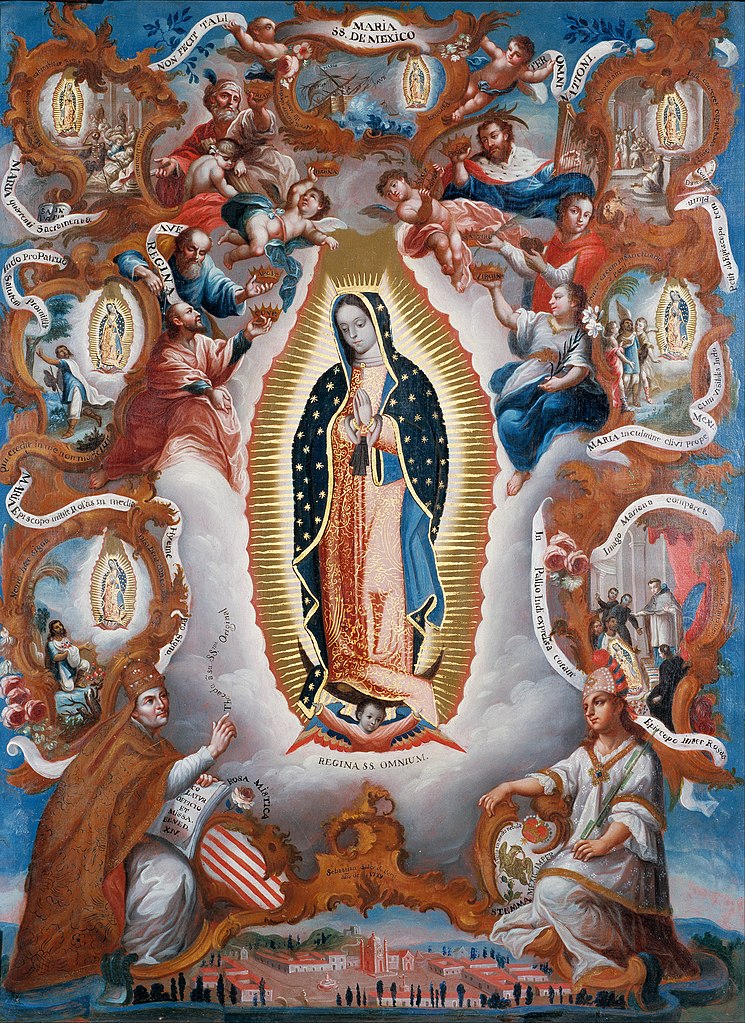“Am I not here who am your Mother?”
The Feast of Our Lady of Guadalupe falls on December 12th, and its renowned image depicts Our Lady during her pregnancy. Thus it lends itself beautifully to the sense of expectation we typically experience during Advent.
The story behind this image, and its message of the power of holy motherhood, are timeless, however. They never fail to uplift and inspire, no matter the date or the season.
The year was 1531; the setting, Mexico, whose ancient indigenous peoples had begun only recently to be converted to Christianity. Human sacrifice of children and adults to appease jealous gods was just one aspect of the native culture greatly challenging Spanish Franciscan missionaries in their efforts toward conversion.
One fairly new native convert to the faith was Juan Diego, a middle-aged, childless widower and subsistence farmer, his only relative an elderly uncle named Juan Bernardino.
In the frosty pre-dawn hours of December 9th, Juan Diego set out on his usual route to the Franciscan mission for early Mass. From the hill called Tepeyac, once the site of a temple to an Aztec goddess, Juan heard heavenly music, and a woman’s voice called out to him by name in his native tongue.
To his astonished eyes, Juan beheld a beautiful young Mexican woman who identified herself as Mary, the Mother of God. Her beautiful garment bore symbols familiar to Juan and indicated that she was pregnant. She spoke to Juan gently, lovingly, charging him with asking the bishop to build a chapel on that site where she could bring her Son to the people, hear their petitions, and show them compassion.
The bishop listened politely to the request of this unlikely visitor, then sent him on his way. Returning to Tepeyac, Juan related this to the Lady, begging her to choose someone noble, more suitable, to carry out her wishes. Her response was no, I have chosen you!
Following Juan’s second visit to the bishop, he carried a message asking the Lady for a sign, which he relayed upon returning to the hill. Return tomorrow, the Lady directed, and I will give you a sign.
On the following morning, however, Juan was not able to return; Juan Bernardino had become gravely ill. Juan spent that day and night preparing herbal medicines and caring for his uncle.
On the morning of December 12th, believing himself near death, Juan Bernardino begged his nephew to run to the mission for a priest. Juan obeyed, circumventing the side of the hill where Our Lady had made her previous appearances. However, she approached Juan from the opposite side, listened to his explanation, and reassured him that his uncle already had been cured.
“Am I not here who am your Mother? Are you not under my shadow and protection?”
Juan obediently carried out Our Lady’s surprising direction that he bring her flowers growing at the top of the hill. From the frozen ground, Juan picked Castilian roses, moist with dew. He returned to Our Lady, who arranged the flowers carefully inside the folds of Juan’s tilma, an overgarment worn by peasants.
His tilma held securely, Juan hurried back to the palace of the bishop, who knelt in amazement at the flowers which fell to the floor, but even more so at the tilma which had contained them. There, the Virgin Mother of God had imprinted the very image which Juan Diego had beheld on Tepeyac.
The tilma of Juan Diego resides today in the great basilica in Mexico City, where millions of pilgrims have viewed the image which has withstood centuries of time. There, Our Lady continues to lead her children to her Son, to hear their pleas, and to show them compassion.
The story of Our Lady of Guadalupe offers clear insights into qualities of a good mother:
A good mother listens to her children …
Our Lady listened to Juan Diego — to his feelings of unworthiness to carry out her requests, to his distress at the bishop’s skepticism, and to his deeply-felt concern for the health of his uncle.
cares about their concerns …
Our Lady showed her care for Juan’s concerns, reassuring him of his suitability for the task, encouraging him to continue his efforts on her behalf, and showing compassion for his uncle’s health crisis.
…and finds ways to help.
Our Lady helped by providing Juan with the visible signs of her presence, not only in flowers miraculously blooming out of season, but more importantly with the miraculous image of herself on his tilma. On a personal level, she eased Juan’s heartfelt concerns for his uncle by healing him.
Writing in A Handbook on Guadalupe, (now Cardinal) Sean O’Malley, O.F.M., Cap., states: “In the apparitions of Our Lady of Guadalupe, in her tender, intimate conversation with Juan Diego, we find everything that would show her motherly care and inspire trust in her wayward children … She has come to show her love, her compassion, her help and protection.”
Further, according to Bishop Robert Barron, “within ten years of the appearance of Our Lady of Guadalupe, practically the entire Mexican people, nine million strong, converted to Christianity … and with that great national conversion, human sacrifice came to an end. She had done battle with fallen spirits and had won a culture-changing victory for the God of love.”
Looking beyond the greeting cards, flowers, and scented soaps — those typical gifts for mothers — we raise our eyes heavenward, to the best of all Mothers; the one who always listens, cares about our concerns, and finds ways to help us. In this, we follow the lead of Saint Juan Diego, who unknowingly blazed the trail for us in a rocky outcrop outside Mexico City nearly five centuries ago.
“Am I not here who am your Mother?”
© All Rights Reserved, Living His Life Abundantly®/Women of Grace® http://www.womenofgrace.com










